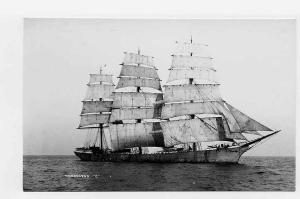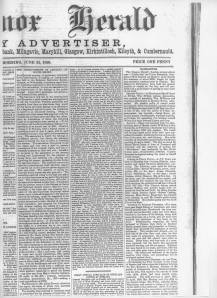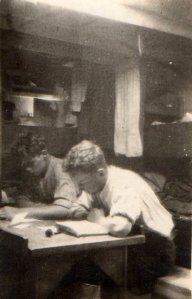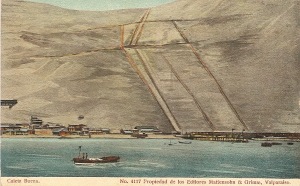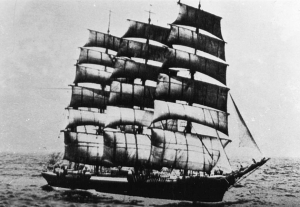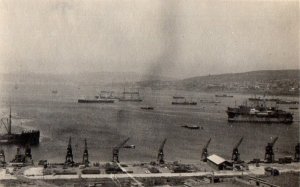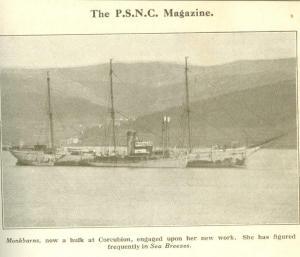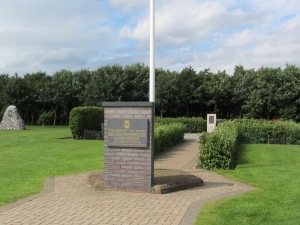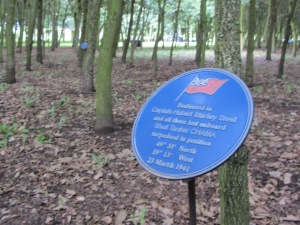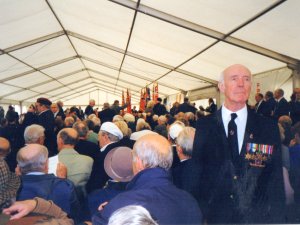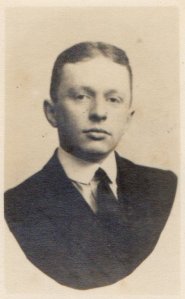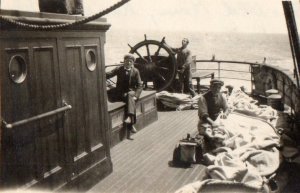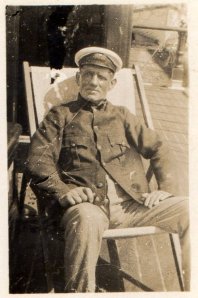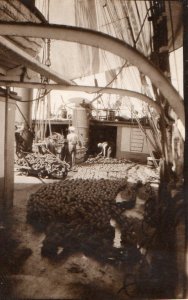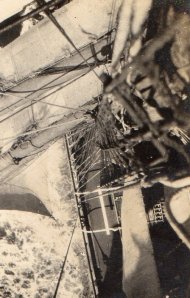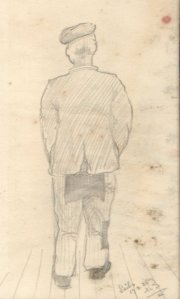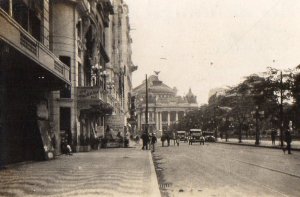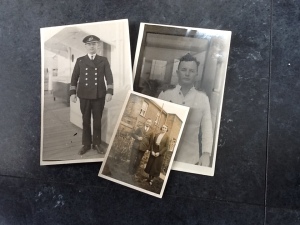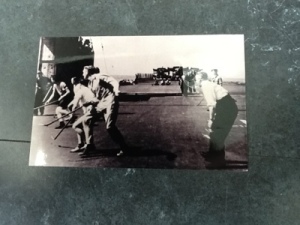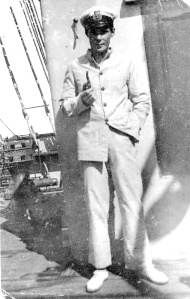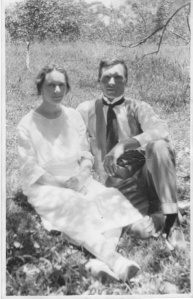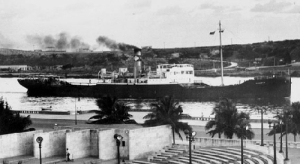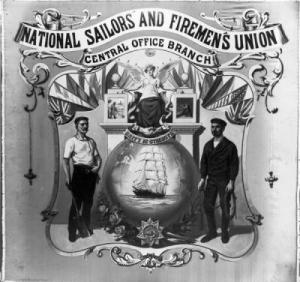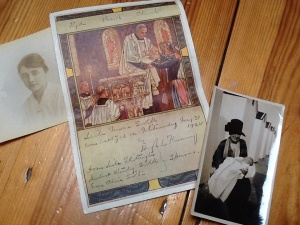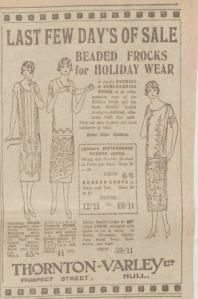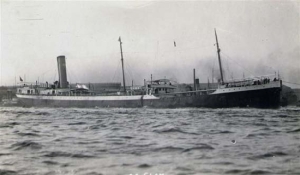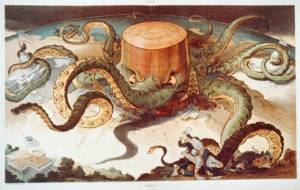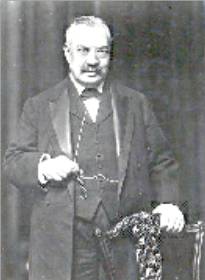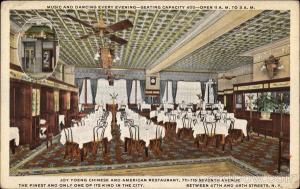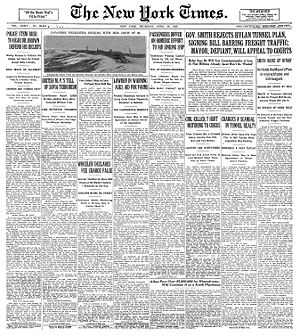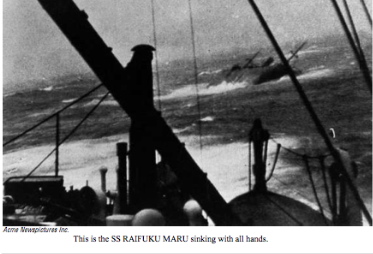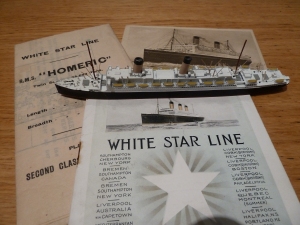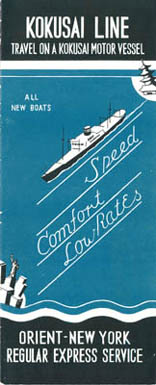Posts Tagged ‘marine marchande’
A sailor’s life – 68. Pyrula and the seamen’s strike, Curaçao 1925
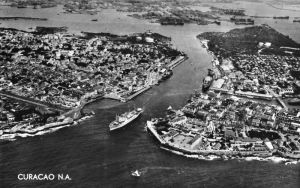
Curacao, St Annabaai – showing the growing Shell refinery and tanker port in the Schottegat, from http://www.hetgeheugenvannederland.nl
The Shell oil tanker Pyrula – formerly the White Star liner Cevic, ex Admiralty oiler Bayol/Bayleaf and one-time decoy battleship HMS Queen Mary – left New York on 21st August 1925 for a new life in Curacao in the Dutch West Indies.
She was manned by a mainly Dutch skeleton crew of 16, including three catering staff and four South American “firemen” (stokers) being repatriated to Maracaibo in Venezuela and Puerto Rico. The young master’s only officer – and the only other Brit on board – was his Scottish chief engineer, George Andrew of Airdrie.
Pyrula was a 30-year-old British steamer with a nominal horsepower of 708 and a working crew of 50, but after four years rusting off Staten Island as a floating oil depot for the Anglo-Saxon Petroleum Company, she faced a final journey of nearly 2,000 nautical miles (3,500 km) down the east coast of the US and across the Caribbean at the peak of the hurricane season, to a small Dutch island possession 40 miles north of Venezuela.
The voyage, the crew agreement notes, was to last for a period not exceeding six months and the sailors were to stand by until the ship was safely moored.
Rocky, dry Curacao was booming. The refinery had opened in 1918 and by 1925 beside the growing tank park, water plant and pending drydock, a little wooden Dutch town had sprung up with its own club house, tennis courts and golf course. Every four days a “mosquito fleet” of tiny tankers poured in from Venezuela with the oil bonanza discovered under shallow Lake Maracaibo, and by July the Isla was processing 5,500 tons of crude a day.
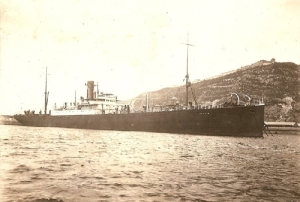
Shell oil depot ship Pyrula – formerly the White Star steamer Cevic, Admiralty oiler Bayol/Bayleaf and decoy Queen Mary
As the oil trade expanded internationally, increasing numbers of tourist steamers too were calling at Curacao, which was handily placed for the Panama canal and the Pacific, and Willemstad was starting to rival Amsterdam for ships and tonnages handled.
Once again,Shell needed Pyrula for bunkering. From the main harbour in the Schottegat lagoon she would eventually move out and round the coast, east to Caracas Bay, as a floating oil pump to the bigger ships unable or reluctant to traverse the narrow St Anna channel between the pretty Dutch gables.
And there she would end her career, overseen by a new master, Willem Hendrikse, and his growing family from a comfy stone bungalow built at the waterside. No more Shell wives made their homes among the old panelled staterooms of the former passenger ship, with their electric fans and bells to the pantry.
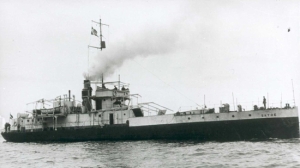
Shell tanker Satoe - former Monitor 24, from http://www.helderline.nl
Hendrikse would eventually have two retired British steamers in his charge. Satoe was one of eight shallow-draft Royal Navy Monitor-class gunships bought up by the Curacaosche Scheepvaart Maatschappij after the first world war. As Monitor 24, Satoe had seen service on the Dover Patrol in 1918 and in the White Sea in northern Russia during the allied intervention after the October revolution, but the “flat irons” as the Dutch called them, were so unsuited to the tropics that the Chinese stokers used to faint from the heat in the holds, he said.
No ship’s log survives in the tidy blue cardboard folder in the National Maritime Museum archives in Greenwich, where Pyrula’s particulars for 1925 have lain crisp and apparently unvisited since the merchant navy records were carved up in the 1970s. The two pages for certificates and endorsements are blank.
Lloyd’s List reports she was one of 13 ships to leave New York that day, and the only one bound for Curacao. So the first hint of anything untoward on Pyrula’s last long passage south is a single undated line on the front of the crew agreement, where her chief officer/acting master, Hubert Stanley Sivell, my grandfather, has added: “Vessel in tow and not under own steam” .
Arrived in Curacao “to be a hulk”, reported Lloyd’s baldly on September 8th.
Twenty-four hours later the men were paid off – in dollars. A small fortune in dollars: $744, worth £153 at the ambitious new exchange rate set that April by the chancellor, Winston Churchill, when Britain disastrously rejoined the gold standard.
Although Pyrula’s crew agreement was the standard UK form, with the usual pre-printed scale of provisions (a pound of salt pork on Monday, a pound and a quarter of salt beef on Tuesday, preserved meat on Wednesday, plus lime juice “as required by the Merchant Shipping act”) and the usual puny 5 shilling fines for everything from possession of firearms to mutiny, Bert’s sailors that trip were not on standard National Maritime Board rates.
Instead of £9 a month – a rate controversially reduced from £10 only that August, and still not including clothing, bedding or time ashore – the Anglo-Saxon Petroleum company paid Bert’s seamen an astonishing $62.50 a month. £12 15s. His firemen were on $67.50, or £13 15s.
In fact the chief steward, H Mulder, 25, who had signed on as humble mess room steward at $50 a month and been promoted to $120 a month before the ship even left New York, was earning only £2 a month less than the Old Man himself – although young Captain Sivell did not advertise the fact. The column for pay against his name in the crew agreement is prudently blank.
Over in North Shields, in the north of England, the British crew of the Shell tanker Acasta – which was shortly to arrive off Curacao to collect Bert Sivell and two other “spare” Anglo-Saxon officers and take them home – would have been highly interested in the pay aboard Pyrula.
Acasta’s pantry boy, 20-year-old Albert Black of Dene Street, North Shields, was on £3 10s a month. He took a £1 15s advance when he signed up, probably to buy oilskins and bedding as he was listed as a “first tripper”, and set up a £1 15s “allotment” to his mother, which left not much. In Tilbury, forty days later, he would be paid off with just nine shillings.
Throughout September seamen with families had run the gauntlet of pickets and opprobrium at dock gates and railway stations up and down the UK to sign on for the new low rate. There were 1.2 million registered unemployed that autumn, but on £9 a month even fully employed seamen found themselves needing to apply for “relief” between ships.
A letter to the editor from a seaman’s wife in Hull in July demands to know how she is expected to pay rent, insurance, coal and “keep respectable” on £1 6s 3d a week. “Now then, all you sailors and firemen, buck up,” she wrote, the night before the cut came in. “What do you pay 1s weekly to your union for, and never one word of protest from none of you? Buck up some of you. Scandalous such treatment for a British sailor.”
By the time Bert Sivell paid off his crew in Willemstad with their wedge of dollars in the second week of September, British shipping was in chaos.
There were pickets on wharves from Southampton to Glasgow, and unemployed men from Cardiff to the Tyne waiting in tugs in the Bristol Channel and off the Isle of Wight to make up numbers as ships sailed shorthanded.
Across the Dominions thousands of British seamen had walked off their ships – 2,500 in Sydney alone – leaving steamers, mail and precious perishable cargoes, including refrigerated meat, maize and 15 million oranges, laid up from Wellington to Durban SA. Thousands of seamen were camped in meeting halls and private homes, fed by the generosity of local families and unions, while the Australian and New Zealand courts sentenced hundreds at a time to jail with hard labour.
And all for the sake of £1 and a vote.
The dispute had begun very low-key on August 1st, when pay on British ships was cut overnight by 10% in an agreement struck between the shipowners and Joseph Havelock Wilson, the president and founder of the National Sailors & Firemen’s Union. It was the seamen’s fourth pay cut in four years, but there was no vote on it, neither for the NSFU membership nor for men in smaller unions not represented on the official national Maritime Board.
When the cut was announced there had been protest meetings and speeches. Letters to local papers outlined the long hours and poor conditions aboard British ships (“only fit for seamen of an Eastern nation…”) and in Hull a disorderly NSFU meeting carried a vote demanding Mr Havelock Wilson’s resignation, which the union officers ruled out of order.
On “Red Friday”, July 31st, as the coal and rail unions were celebrating victory over the government of Stanley Baldwin, 200 seamen in Hull voted to strike.
The miners and railway workers were big hitters who had threatened a general strike over the mine owners’ plans to cut pay, (which was £3 a week in Staffordshire and up to 13s a day in Scotland) and faced with the prospect of the country being brought to a standstill Baldwin had backed down. He agreed to subsidise the industry for nine months, pending an inquiry (- which would lead to the general strike in May 1926, when the royal commission came back with a recommendation to cut the miners’ pay anyway, but by then the government had emergency plans in place – and volunteers on standby to drive buses and trains.)
But there was no similar support for the seamen. The NSFU stood by its sweetheart deal with the shipping companies, so the TUC – and even the breakaway Amalgamated Maritime Workers’ Union – considered the action “unofficial” and would provide no fighting fund. Within weeks, seamen refusing to sign on at the lower rate were deemed “unavailable for employment” and cut off from the dole.
Newspaper reports of the meetings of the workhouse guardians record debates about basic food relief, to prevent the wives and children of strikers “actually starving”. The men, it was agreed, should get nothing.
On August bank holiday weekend the Hull Daily Mail’s man at the dockside described the crowds of happy day trippers who piled unmolested onto the steamers Whitby Abbey and Duke of Clarence, despite the seamen’s strike. “There was no disturbance beyond a fight between two small dogs; a policeman on duty yawned continually, apparently bored with the inactivity of the ‘strikers’,” he sneered.
Up and down the country for the first three weeks of August ships sailed, and wherever men refused to sign on at the lower rate there were plenty of others hungry take their places.
Times were hard. The first world war had cost Britain her export markets. As the chancellor, Winston Churchill, wrestled with reparations and repayments, his overambitious return to the gold standard was having a depressing effect on Britain’s balance of trade. (Nations united by the gold standard, he had said that April, would “vary together, like ships in harbour whose gangways are joined and who rise and fall together with the tide…” Eurozone countries please note.)
Struggling to compete on price, British manufacturers cut pay. And kept cutting.
Even on the Isle of Wight unemployment was rising, from 1,000 in January 1925 to 1,538 by Christmas, but the situations vacant column in the local paper there (mainly seeking servants) was still three times the length of the situations wanted. Niton needed a gas lamplighter, the County Press reported, and a married woman teacher in Dorset had won a ruling in Chancery preventing the school governors terminating her employment, “even though there were single women teachers wanting for work”.
Seamen were largely casual labour, and even on £10 a month often could not lay enough by to feed, clothe and house a family during the growing gap between ships. To strike against the NSFU, cut off both from unemployment relief and union support, meant hardship.
By the middle of August it looked like the strikers might be starved out. But industrial relations took an unexpected turn when the first British ships started arriving in Australia after the three-week passage, and an energetic seamen’s union recently victorious in its own battle over pay and conditions took up the cause.
By the time Pyrula arrived in Curacao, the strike had taken a grip in the UK itself.
“Two thousand three hundred passengers, practically all Americans, booked to sail tomorrow morning from Southampton to New York on the White Star liner Majestic were at their wits’ end today,” the New York Times correspondent TR Ybarra cabled on September 1st, “trying to find out whether the Southampton seamen’s strike would force the Majestic to postpone her sailing.” Bristol, Hull and Liverpool were also affected, he said.
In South Africa, desperate fruit growers clubbed together to pay the disputed £1, just to get their oranges away. “The fruit interests are emphasising that for a matter of £70 in wages in this ship Roman Star £300,000 worth of fruit is being jeopardised, which if lost, will mean the ruin of many small producers,” the Western Morning News reported.
In Avonmouth, 30 boilermakers working on an Eagle Star tanker in dry dock downed tools. The San Dunstano needed enough work to keep 300 men employed until Christmas, they said, but they were being asked to just make her seaworthy to reach Rotterdam, where the Anglo-Saxon Petroleum company had already sent the US-built Ampullaria. With 400 men locally unemployed it was “not right to send three months work to the Continent”.
“A MILLION TONS HELD UP BY SEAMEN’S STRIKE”, shrieked the NY Times on the 17th.
With the country’s maize and citrus exports rotting on the wharves, the South African government tried to mediate – mooting a six-month inquiry, as put in place for the miners, but the shipowners said no. Union Castle began to recruit “lascar” crews in Bombay, but India and South Africa both protested – though for different reasons.
As well as their £1 back, and paid overtime, and an end to the NSFU’s closed shop deal with the ship owners, the strikers wanted a ban on cheap Chinese and “lascar” crews.
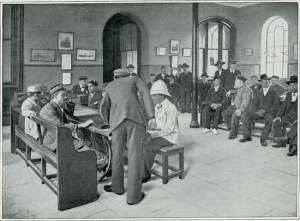
Asiatic seamen in the Strangers Home, West India Dock, London. Memorial University Newfoundland website
Wartime restrictions on enemy aliens living in the UK had been extended after the war, limiting employment rights for foreign nationals and barring them from certain jobs (including the civil service). The act had particular impact on foreign seamen working on British ships, and was encouraged by British trade unionists fearful of the cheap competition for jobs. [It was expanded again in 1925 by the Special restriction (coloured alien seamen) order, and even more shamefully not repealed until 1971]
Under so called “lascar agreements” big British firms like Union Castle signed up Asian crews as a job lot for a round trip, under a serang. They did not have to be paid British rates, because they were not signed in British ports, and they were expected to put up with grossly inferior conditions for reasons that can only be described as racist.
Acasta’s white British crew had themselves taken the place of 38 Chinese seamen and firemen who were signed off in South Shields on September 10 after 11 months’ service between Trieste, Malta, Panama, Montreal, Las Palmas and Marseilles.
These men were all registered to boarding houses in the same three streets in Rotterdam – Atjehstraat, Delistraat and Veerlaan, and their pay per month of the trip cost Shell even less, an average of only £3 a head.
Many Chinese had appeared in the tiny docklands peninsula of Katendrecht in 1911, signed up in secret by Dutch ship owners as strikebreakers to work the big passenger liners to and from the Dutch East Indies. They had no unions, only “shipping masters”, who allocated ships and rented beds in their boarding house between jobs.
The Chinese had a reputation as hard workers. They did not drink, were docile with their pipes and mahjong (“less troublesome than a white crew,” said Bert), and were willing to work for little pay.
They were also expected to eat less than a white crew, according to a typed “Scale of Provisions (Chinese)” tidily appended to Acasta’s crew agreement by Captain G. Croft-White. Although the same document shows fireman John Sow had to be left behind in hospital in Marseilles that trip suffering suspected beri-beri.
Shell’s Chinese seamen were entitled to 7lbs of beef, pork or fish each per week, against 8lbs allocated for white crews, and they got 10 and a half lbs of rice, instead of 11lbs of potatoes, biscuit, oatmeal and rice. They got less coffee, marmalade, bread, sugar and salt, more tea and dried vegetables, and no dried fruit, suet, mustard, curry powder or onions at all.
Capt Croft-White was clearly a belt and braces sort of chap, for above the scale of provisions is also gummed a paragraph from a printed document outlining the National Maritime Board’s absolute jurisdiction over pay board his ship, including its ability to retroactively impose cuts.
“It is agreed that notwithstanding the statements appearing in Column 11 of this Agreement the amounts there stated shall be subject to any increase or reduction which may be agreed upon during the currency of this Agreement by the National Maritime Board …”
Bert spent a month in Curacao, handing over and sorting out paperwork, but no letters survive. Only Acasta’s crew agreement shows that he was picked up “at Sea” on October 20th with two other British officers from Dutch lake tankers, and conveyed home to Tilbury.
He arrived back in Britain in November 1925. The strike was over. The seamen had lost.
From Australia came reports of violent clashes between police and British strikers in Fremantle, but after 107 days the men there too gave up and started trying to sign up for a ship home.
It was the loss of trade that eventually beat the seamen’s strike, as farmers and woolmen facing ruin eventually turned on the cuckoos in their nest. Lost, delayed and diverted trade was estimated to have cost £2 million. The shipowners claimed it was a Red Plot.
On December 8th, the Western Argus in Kalgoorlie, Western Australia, ranted: “The anti-British character of the strike was plainly shown by the action of the agitators who fomented it in Australia. They professed sorrow and indignation over the unhappy British seaman, compelled to starve on a miserable pittance of £9 a month, but they said nothing about the German seamen working for £4 4s. All their efforts were directed to holding up the British shipping trade, while foreign vessels were allowed to come and go unhindered…”
After more than four years away Bert hurried home the Isle of Wight for a rare Christmas with the wife he had not seen for a year and the baby daughter he had never met at all. His furlough pay as chief officier was £24 10s a month.
Read on: In Memoriam
Previously: Cabinned, cribbed, confined
A sailor’s life – 67. Cabined, cribbed, confined
Ena Sivell didn’t have the vote when she married her sailor sweetheart in 1922 aged 26. She didn’t have a home or signing powers on her husband’s bank account, and when she gave birth to their first child 3,000 miles away from her husband in a nursing home in Ryde, Isle of Wight, three years later he did not meet the baby until it was learning to walk.
Anglo-Saxon Petroleum (Shell) – having permitted the young first officer in charge of its New York depot ship Pyrula to keep his bride aboard ship with him for two glorious years – had ordered Ena off at the first sign of pregnancy and she took her bump and her souvenir Broadway programmes and went back to the town where she was born, to make a temporary life in rented rooms, dependent on her father-in-law for paying her bills until her husband came home, which tried her sorely.
But Bert stayed on. And on.
Tradesmen’s families like Bert’s and Ena’s did not have telephones, and communication between husband and wife was by letter – two weeks out, and two back by the great transatlantic liners that swept to and fro between Hamburg, Southampton and New York in the days before air travel.
The baby was born in March, too weeks overdue. Ena – flat on her back in bed with her knees tied together, in the approved treatment of her day for a torn perineum – sent off a telegram to the States.
Bert was hugely relieved and rang all their American friends at their places of business from the ship’s phone line, fixing himself up with dinner and a trip to the Hippodrome with Ena’s chum Florence in the process.
His first letter reached her two weeks later. “I’m really a little disappointed that a girl has come along,” he wrote, with jaw-dropping insensitivity. “I would have liked a boy. But as Mrs Franke Snr told me Monday – I cannot change it now!! Mrs Mercer says I must try again …!!”
And he was no better at reassurance for his stretched little wife’s sagging self-esteem. Dismissing the rupture in his next letter with all the carelessness of a man who has never tried to pass a watermelon, (“Never mind, you’ll soon be alright again”), he added: “I cannot quite agree with the doctor that you are decidedly on the small side, my dear, although if he says so we ought to be glad you are no bigger.” Nearly 90 years later I still want to hit him.
Bert Sivell was a conservative, with a big and little C. An only child who had run away from home aged 15, he had grown up at sea, far from “decent girls,” as he put it, except for the Mission families in Australia, and the master’s daughter, Jeanie Donaldson, who made one trip with Monkbarns as stewardess in 1917. He didn’t approve of women shingling their hair, or wearing trousers.
His was a man’s world. A month after his daughter’s birth his letter home was full of the five new oil tankers that Furness Withy had ordered from German shipyards. They had offered British firms substantially more to take the work, he reports. “But owing to the labour conditions, the British firms could not take the offer. I am rather surprised that the ASP have placed orders for four new tankers* with British firms, because they are paying through the nose for them,” he wrote.
“By the way, dear, you have still not told me yet what the baby’s name is going to be…”
If the baby had been a boy Ena had suggested John Thomas, which Bert had vetoed by return of post. It was slang for penis, familiar to readers of DH Lawrence’s novel Lady Chatterley’s Lover, the third of three versions of a story that Lawrence would publish three years later in 1928, although it was 35 years before it could be openly sold in the UK. “The name John Thomas is unsuitable,” wrote Bert, “although you should not know what it means.”
When he finally got home in November, he carried in his trunk a well thumbed copy of Dr Alice Bunker Stockham‘s pioneering sex guide Karezza, recommended by a chum and bought at Wanamaker’s wonderful bookstore in New York. He had read it cover to cover.
They had also acquired Dr Marie Stopes equally controversial Married Love, which he had persuaded a reluctant Ena to have sent to the house in a plain brown wrapper.
“When I get home again we are going to be as happy as happy can be, aren’t we, darling?” he had written. “Especially with this new information I have gathered. We were going at things in a wasteful sort of way before…”
Read on: The seamen’s strike 1925
Previously: Clam, a moment in history
*[These would be the 10,000 DWT Bullmouth, Bulysses, Patella and Pecten; another six orders went to Dutch yards]
A sailor’s life – 66. The Clam, a moment in history
“The old Clam is up to her tricks again: early this week she decided to take a sudden list, after standing perfectly upright for over two months. We had to chop through a foot of frozen snow and ice to get to the tank lids and then we had to use a crowbar to get them open. She was not leaking, so I do not know the cause of her latest crankiness.”
Bert Sivell, officer-in-charge Shell depot ships Pyrula and Clam, New York, January 1925
In the winter of 1925, the East River in New York froze, trapping the ferries. One morning Bert Sivell found he could almost walk from his home on the former passenger liner Pyrula at Stapleton NJ to his support tanker, the 3,500 ton Clam, across the ice that stretched half a mile into the bay.
The steam was off, there was no oil cargo aboard either vessel, and no ships calling for bunkers. The Anglo-Saxon Petroleum company (fleet arm of the 1907 merger of Royal Dutch Petroleum with the “Shell” Transport & Trading co.) was shedding its old tankers and both vessels were up for sale – for £25,000.
Pyrula was just an old passenger steamer, converted to an oil tanker by the Admiralty during the first war when she had seen action as a dummy warship, but Clam – though older – was a pioneer: a bit of Shell history.
The Clam was a proper oil tanker, purpose-built to carry lamp oil in bulk a decade before the word “tanker” was even invented, in the days before ordinary householders could dream of electric lighting and when gasoline was still a worthless byproduct being run off into rivers from Pennsylvania to Azerbaijan.
Launched in 1893, the Clam was older than her newly-wed young officer-in-charge, and older even than the old square-rigged sailing ship in which he had served his sea apprenticeship.
She was the last of the very first “Shell” tankers; the fourth of four sister ships designed in secret in 1892 to challenge the monopoly of American oil and its “Octopus Standard Oil by carrying Russian kerosene in bulk to the burgeoning markets of the East through the Suez Canal.
Murex, Conch, Turbo and Clam were a sideline to the rice and case oil business of a self-made British family, the Samuel brothers; a bow drawn at venture, rather like the workshop Samuel senior had founded, sticking exotic shells on tricket boxes for the booming Victorian seaside souvenir trade.
They were not the first purpose-built bulk oil tankers* – a distinction that belongs to either the Belgian Vaderland (1872), the Swedish Zoroaster (1878) or the German Gluckauf (1886), depending on your definition – but they had reinforced bulkheads up, down and across creating multiple separate tanks; cofferdam “buffers” fore and aft, isolating the fiery boiler room and coal bunkers; and expansion tanks to contain the expanding cargo in hot weather and prevent it shrinking and lurching in cold. They had water ballast tanks, to empty in case of grounding; electric fans to expel explosive gas vapours; integral pumps; and steam pipes for cleaning between wet and dry cargoes (!) – for purpose-built or not, the Samuels could undercut the competition if their oil tankers carried a cargo of tea back.
The ships were leak-proof, collision-proof and as far as possible fire-proof, and in August 1892 Murex made history as the first bulk oil carrier ever to pass through “the ditch” and into the Red Sea, bound for Thailand. She carried with her a little murex shell, presented to the master by Marcus Samuel from his own collection.
The Samuels were not Rockefellers. They were Whitechapel Jewish importers of rice and grain, semi-precious stones and shells, but they had inherited a network of trading agents across the far east and together they set up a syndicate to build onshore storage tanks that eventually stretched from Shanghai to Batavia (Jakarta), and from Bombay to Kobe. They worked in secret, because the ruthless Standard Oil had ways of seeing off competition – until it was finally forcefully broken up by US anti-trust laws in 1911.
Gradually, the eponymous rusty blue-green of Devoe’s Brilliant case oil tins – which had built itself into the very fabric of villages across the East as raw materials for everything from roofing tin to toys – gave way to shiny red ones, manufactured on the spot, and in 1897 the Samuel brothers struck oil of their own, in eastern Borneo, north of an unspoiled little fishing village called Balik Papan – (now an oil city of half a million souls.)
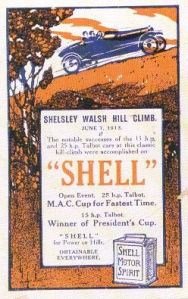
Shell oils advert for the Shelsley Walsh Hill climb 7 June 1913. Sir Marcus swiftly allied his products with pioneering motoring and aviation attempts
The following year, when the “Shell” syndicate began converting its tank steamers to burn its own thick fuel oil, Clam was first.
By 1925 only the Clam was left. Conch was wrecked off Sri Lanka (Ceylon) in 1903; Turbo went down in the North Sea in 1908; Murex was torpedoed outside Port Said in 1916. But the Clam – requistioned by the Admiralty for service as RN oiler No. 58 and torpedoed in the Irish Sea by UB64 – limped into port and returned to work.
By 1925, there had been a hundred and twenty-seven “shell” tankers, including Murex (2), Conch (2) and Turbo (2). Marcus had been knighted for services to the Admiralty, and then raised to the peerage as Lord Bearsted. The “Shell” syndicate had merged with the Royal Dutch and oil was big business from Indonesia to Venezuela, producing all manner of oils, thick and thin, including the once despised gasoline and new aviation fuel.
The Clam was an antique – old and cranky, flip-flopping at her moorings in the ice and fog off New York, minded by a young officer-in-charge apparently whiling away his time with prize crosswords and letters to his wife far away in the UK, and a young engineer juggling three girlfriends. (“… He met them at a dance hall he goes to. He takes them all out on different nights and has been buying them presents too. I think they are soaking him good…”)
America was still supposed to be “dry” and at Christmas the manager of the Asiatic Petroleum co. [Shell’s management arm] had brought them a basket of fruit and some cigars, which Bert shared with his last few Chinese sailors. “Their forecastle will be all right tonight with cigar smoke and opium,” he commented. He saw in the New Year out at the moorings with Clam, listening to all the ships around him rattling their whistles. (“Not a sound from Pyrula, not even the bell.”)
Up in New York, the Ford Motor company was pulling crowds with a two week exhibition at its showroom on 54th and Broadway, where you could watch twenty-five workers assemble a motorcar they themselves could afford to buy – start to finish in 20 minutes flat.
Bert joined the gawpers. “They build them on a moving conveyor,” he wrote. “The men never move from their positions but just do their bit to each machine as it comes to them. Finally the machine rests on its own wheels and they start the engine and drive it away. It really is a wonderful piece of organisation.”
The (free) show included entry to a prize draw to win your own car. Bert managed three trips, and three entries to the draw. He was already scouring the local paper his parents sent him for a house with a garage. “I made up my mind some time ago that I would have a car during the first leave after I go master.” That would be 1928, by his calculation.
Although he had passed his master’s ticket in 1919, promotion in the “Shell” depended on seniority. Every company man kept a jealous eye on the men above and below him on The List, and the only bearable part of the drudgery and boredom of minding Pyrula and Clam that final year was the fact that it all counted. “The old idea about sea experience is dead in this era of steamships,” he grumbled, ungratefully.
Once a week he left the pier and caught a vaudeville show off Broadway. “There’s a new idea at the Liberty now,” he wrote in January. “On Monday and Tuesday there is no vaudeville, but two pictures (movies) instead, admission 25c and 35c. Wednesday night is Opportunity night when the local talent give the vaudeville and prizes are awarded by the audience’s applause. We get the two pictures as well, admission 40c over all. Some of the local talent is terrible.”
Once a week he lunched at Yeong’s Chinese restaurant, where he would listen to the jazz bands and watch the dancing, wandering back to Pier 14 via the bookshop on the eighth floor of Wanamaker’s in Washington Square.
The American Sugar refining company turned up in February, looking for a Cuban depot ship “if the price was right”, followed in March by two more Italian gents (“because they gave me a cigar”) and a firm of Danish ship breakers. Both made offers and both sought Bert’s services as master to sail and tow both vessels back to Europe. But the Anglo-Saxon said no.
It said no again when a German shipbreaking firm in Hamburg bid £23,500. (“As luck would have it we were both in our overalls and pretty black. I have all the boats turned inside out and Andrew has part of the main engines adrift ready to go to sea, so we had quite a decent show for him.”)
By now six of the war generation tankers had been sold that Bert knew of: Caprella (ex War Gurkha), Conia (War Rajput), Melona (Elmleaf), Prygona (Aspenleaf), Strombus (RN oiler 4) and Cardium. Bigger ships were on the stocks. Bert boxed up four years of clutter and destroyed all Ena’s early letters, ready to go home. And nothing.
The baby was born in March, but in April he was still showing prospective buyers around Pyrula and Clam, without success. “It is pretty evident now that the ASP have abandoned the idea of selling these ships for operating tonnage and they are now looking for the best price for junk.”
The Clam was eventually sold to Petrolifera Esercizi Marittima of Venice in 1926 and renamed Antares. The following year Shell launched a 7,400 ton Clam (2). Pyrula was moved to Curacao, still as a depot ship, and scrapped in 1933. Antares/Clam outlasted them all. She finally ended her long career after she was torpedoed by the Italian submarine Alagi in 1942. She was refloated but scrapped the following year.
By then, Bert was dead. He never did get his motorcar.
Read on: Maybe baby
Previously: Homeric and the Raifuku Maru
* In 1861 the first recorded ship to carry (US) oil in bulk, the tiny two-masted sailing ship Elizabeth Watts, sailed for England with a drunken, crimped crew – no sober volunteers having been found willing to risk their lives with such a hazardous cargo.
